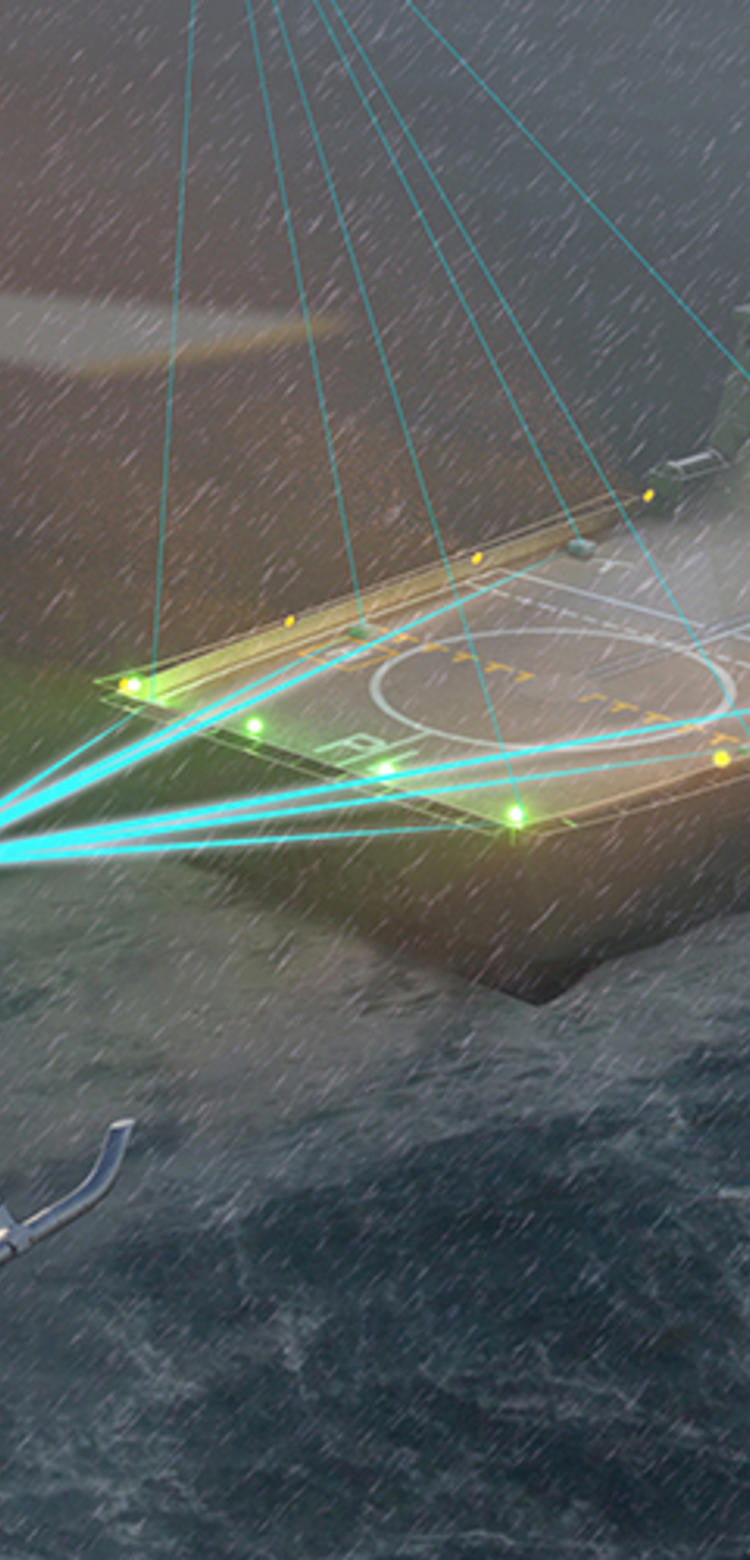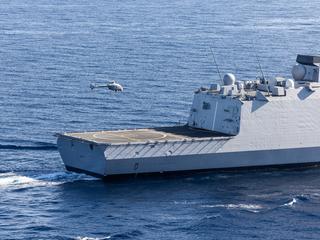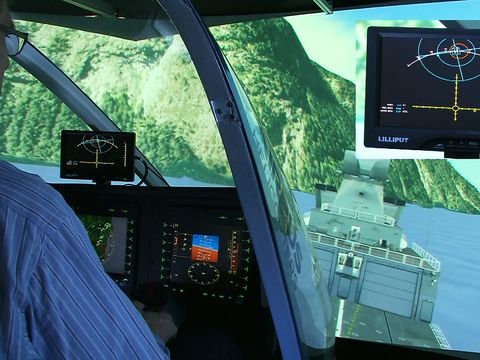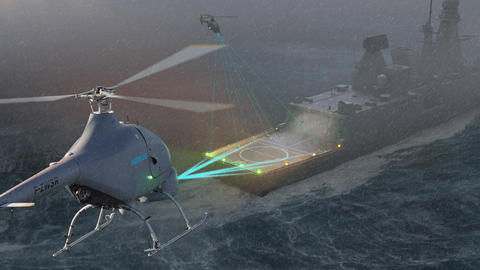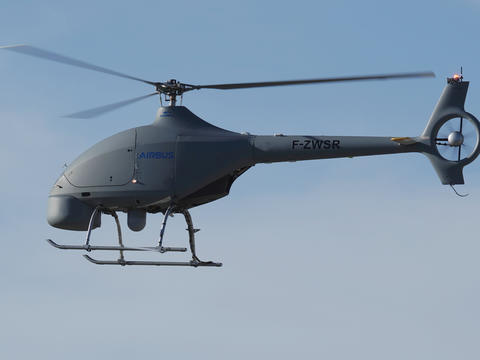The high precision local positioning system
For all weathers
DeckFinder™ is a local positioning system that enables manned and unmanned aerial vehicles to determine their relative position in the harshest environmental conditions. The navigation system contributes to easier and safer take-off and landing procedures in GPS-shaded environments that lack reference points or visual cues.
When landing on small or moving helidecks, a difference of a few centimetres can compromise and endanger a whole mission. To mitigate such risk, DeckFinder™ provides a 3-dimensional image of the UAS’ relative position, aiding in the safe landing of the aerial vehicle.


Highlights
- Proven and fully integrated into multiple leading UAS platforms
- GPS/GNSS-independent for safe landings in any weather, even at night, in dense fog, rain and storms
- Licence-free radio frequency-based solution
- Ad-hoc temporary or permanent installation possible
- Line and/or battery-powered
- Rugged system components to withstand harsh environmental and operational conditions
- Operational temperature range from -32°C to +55°C
- Lightweight components
- Standardised interface to connect to downstream resources
Download DeckFinder Brochure
DeckFinder Brochure
DeckFinder Brochure
DeckFinder Brochure
DeckFinder Brochure
Product overview
DeckFinder™ is a high-end positioning sensor that supports naval operations by ensuring an elevated degree of positioning accuracy of 10-20 cm, especially during take-offs and landings. The system can handle dynamic situations with an update rate of 33 Hz and a scalable operation area up to 300 metres. Its components are designed to perform optimally in harsh conditions: the rugged Ground Station Units (GSU) are built to withstand extreme temperatures ranging from -32°C to +55°C, and the 1.6 kg airborne equipment can operate in salt water environments.
DeckFinder’s three segments work in triangulation. The Ground Segment includes the components installed on the landing spot, an Airborne Segment corresponds to components on the aerial vehicle itself, and a Monitoring and Software Control Segment consists of management software that updates the vehicle’s position on a flight display or the data interface. DeckFinder™ ground stations can be installed on any fixed or moving ground base.
DeckFinder™ works with multilateral, independent RF-based ranging signals. Distance measurements are done on a proprietary measurement principle in a licence-free RF band that is independent from the Global Navigation Satellite System (GNSS). This innovative technique serves to determine the range between the ground station antennae and the airborne segment antennae with a high degree of accuracy in a local area.

Missions
DeckFinder™ enables fully automatic take-offs and landings for helicopters, manned and unmanned aerial vehicles, and is operative on stationary and dynamic surfaces.
DeckFinder’s standardised data interfaces enable it to connect with most autopilot systems in manned and unmanned helicopters, allowing the autopilot to perform an exact landing in difficult situations such as on moving ship decks, trucks, as well as in GPS-shaded or reduced visibility environments. In addition, thanks to its standardised data interfaces, DeckFinder™ can adapt to customer requirements.
Landing on moving surfaces
DeckFinder™ aids rotorcraft landings on moving ship decks and during offshore operations. For landings involving a pitching and rolling ship deck, DeckFinder’s system of reference points integrated on the ship deck itself enables safe navigation.
The same principle can be used for landing a UAS on moving trucks. During military operations or convoy surveillance missions in areas where GPS may be jammed, the safety of vehicles depends on staying in motion. DeckFinder can assist accordingly with safe recovery of UAS in such circumstances.
GPS-shaded and reduced visibility environments
GPS-shaded environments affect aerial vehicles near offshore platforms and in urban and mountain areas, limiting the autopilot’s efficiency. DeckFinder™ provides crucial landing assistance in these situations.
Another variant of visibility is weather. With its independent positioning assistance, DeckFinder™ overcomes GNSS performance, supporting landings even in extreme conditions such as thunderstorms, blizzards, or dense fog. Further, DeckFinder’s accurate measurements and rugged components operate just as efficiently in harsh environments with vibrations, salt water projections, dust or extreme temperatures.
Concept overview
Ground segment
The Ground Segment uses six ground units (GSU), placed on the landing pad according to a predefined geometry, to calculate the distance of the airborne vehicle from the ground.
The GSU antennae emit RF-based ranging signals that, once received by the Airborne Segments, are used to determine the UAS’ relative 3D position to the Ground Segment.
Airborne segment
Three airborne units calculate the distance of the airborne vehicle from the ground. The Range Measurement Unit (RMU) is connected to two antennas positioned at the front and back of the airborne vehicle and oriented downwards. A Positioning Calculation Unit (PCU) is connected to the RMU and an optional Altimeter via two serial interfaces.


Services
DeckFinder™ comes with service support during installation, operation and maintenance. The service support includes:
- Simulation models and simulation support
- Integration and test support
- Planning and model design
- Installation and commissioning
- Operator and maintenance training
- Documentation (manuals, datasheets etc.)
The latest UAS news
in the spotlight
-

European Maritime Safety Agency selects Airbus Flexrotor drone for maritime…
Press Release
Helicopters
Airbus has been awarded a framework contract by the European Maritime Security Agency to provide multipurpose maritime surveillance with the Flexrotor UAS. -
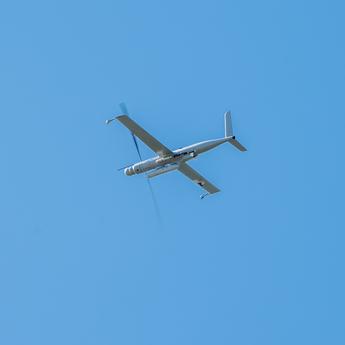
Uzbekistan to operate Airbus Flexrotor uncrewed aerial system
Press Release
Helicopters
-

Spain takes off in the age of crewed-uncrewed teaming
Web Story
Helicopters
-
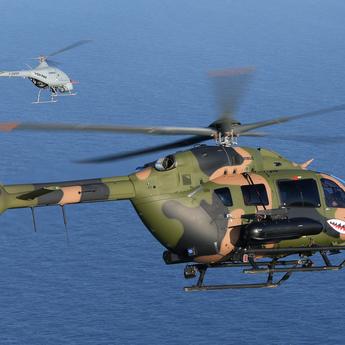
Helicopter-drone collaboration
Web Story
Helicopters
-

Airbus streamlines its tactical uncrewed aerial system offering
Press Release
Helicopters
